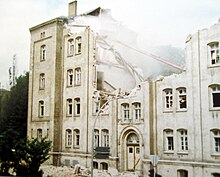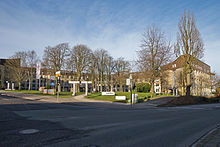Duburg (city district)
Duburg ( Danish Duborg ) is a district of the independent city of Flensburg . The name of the area goes back to the Duburg fortress , which up until the beginning of the 18th century protected the port town in the valley below. Until 1875 Duburg formed an independent rural community . Nowadays, the Duburg area is assigned to the Neustadt district, especially by the Flensburg administration, and is only designated as an urban district, although it is often classified as a separate district.
history

In the Middle Ages, the place of the Duburg was a nobleman’s court. While the neighboring farms were bought up and their area was added to the city as a city field at the latest when the Flensburg trading center was granted city rights on December 28, 1284 , the farm on the Marienberg just above the city was expanded into a lordly castle. This became the center of the Flensburg office , to which the city itself did not belong, so that the Duburger Schlossgrund formed an administrative enclave on the city field.
After the Great Northern War 1700–1721, in which the castle was no longer of any military importance, the fortress was abandoned and dismantled. The administration moved into a new building at the south-western end of the palace district, while a small settlement was built north of the palace gardens. A few residential buildings were built here (mainly by captains from the city), but also businesses and two windmills. The only access to the nearby city was the narrow Schlossstrasse, which led into the Ramsharde , the northern part of Flensburg's old town.
At the beginning of the 19th century Duburg already had about 170 inhabitants. In 1801 the administration moved to the Fischerhof east of Flensburg's old town. Although Duburg grew closer and closer to the city, it remained administratively connected to the Flensburg office and belonged to the Wiesharde legal and police district . In church matters one had to go to the e. the distant church in Handewitt , although the St. Mary's Church in Flensburg was in sight.
Even after the introduction of the Prussian administration after the German-Danish War of 1864 , Duburg remained independent and established itself as an independent rural community . In 1875, however, it was incorporated into Flensburg almost at the same time as the eastern Flensburg suburbs, Fischerhof and Hohlwege . In the following decades Duburg was built on in a big city. But it was not until 1895 that the Evangelical Lutheran residents of the parish of the nearby St. Mary's Church were added.
present

Today Duburg is the seat of numerous authorities and schools, whose importance goes beyond the city of Flensburg. These include above all the Flensburg tax office (on the edge of the Westliche Höhe ) and the job center of the Federal Employment Agency . The St. Francis Hospital in Malta is also in the area. The larger of the two Flensburg hospitals, the Diakonissenanstalt, is not far from the Maltese hospital in the Westliche Höhe district . (The Diakonissenanstalt emerged from a hospital that was set up in the old office building from 1801. ) In addition, the municipal commercial college and the Danish grammar school Duborg-Skolen , by whose name the Duburg district is better known in Denmark than in Schleswig, are located here -Holstein.
As a residential area, Duburg offers a very mixed ambience, from large apartments with a view of the city to typical workers 'apartments, including the first houses built by the Flensburg workers' building association in Bergstrasse from 1881. Most of the once numerous smaller shops and restaurants away from downtown Flensburg have closed in the past 5 to 15 years.
More buildings
- In 1881/82 the Voigtschule was built on Duburg, which was only given up as a school location in the first 2000s.
- 1885/86 construction of the Plaetner Heim .
- In 1903 the Mohr'sche Heim was set up on Duburg.
literature
- Dieter Pust: Flensburg street names. 2nd revised edition. Flensburg 2005.
- Gerret Liebing Schlaber: Fra opland til bydele. Flensborgs bymark and de indlemmede landsbyer i photo and text approx. 1860–1930. From the country to the district. Flensburg's Stadtfeld and the incorporated villages in pictures and words approx. 1860–1930. Flensburg 2009.
- Karl Weigand: Flensburg Atlas. The city of Flensburg in the German-Danish border region, past and present. Flensburg 1978.
References and comments
- ^ City districts, published by the City of Flensburg ( Memento from February 24, 2016 in the Internet Archive )
- ↑ See, for example, Die Duburg - Gesellschaft für Flensburger ( Memento of the original from June 21, 2015 in the Internet Archive ) Info: The archive link was inserted automatically and has not yet been checked. Please check the original and archive link according to the instructions and then remove this notice. ; accessed on March 30, 2014.
- ^ Writings of the Society for Flensburg City History (ed.): Flensburg in history and present . Flensburg 1972, p. 413.
Web links
Coordinates: 54 ° 48 ' N , 9 ° 26' E
